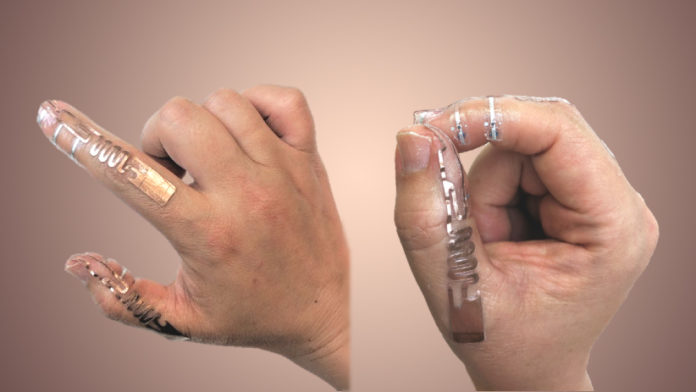In the operating room, surgeons and other staff in the surgical field have to stay clean. That means they can’t touch anything that isn’t sterile after scrubbing in, including computers that they may need to access to look at pre-operative planning diagrams or medical imaging.
So what if there was a way to wear an input device inside their gloves, allowing them to navigate by touching their fingertips together?
That’s the idea behind Tip-Tap, a battery-free and wireless input device created at the University of Waterloo. It’s made by splitting the antenna of a radio frequency identification (RFID) tag and adding three chips to each half. Worn on the index finger and thumb, bringing a chip on one side into contact with one on the other produces an electrical signal.
RFID tags are inexpensive and common, and many will recognize them from contactless payment chips on debit and credit cards. They don’t require their own wires or battery power, collecting the energy they need from radio waves from nearby RFID readers.
Designing an input device that fits like a glove
Tip-Tap can be worn inside sterile gloves, either attached to the gloves or worn as a temporary tattoo on the skin. The chips give up to nine pairings that could speed up computer access when in an environment where minutes matter.
“What typically happens now with operation digital preplanning is that an assistant is responsible for navigating the computer and communicating with the surgeon, but this is slow and difficult,” said Daniel Vogel, professor of computer science at the University of Waterloo, in a press release.
“If the surgeon tries to navigate it themselves using a touchscreen or a mouse, it’s problematic because it would require constant sterilization, and current alternatives such as big gestures tracked by computer vision can get very tiring.”
The design process started in a very low-tech way, asking volunteers to put on a glove with a small ink pad on the thumb. To see how far users could comfortably reach, they tapped an oval of dots on various positions on their index finger. The team cut open the index finger of the glove to create a flat a reachability map. The rows of three chips were then placed in a line within that reachability area.
Next they tested three different kinds of interfaces to see which ones were most usable: a completely smooth surface, a surface with pits and bumps to help indicate when a pair of chips are in contact, and a series of magnets that help pull the chips into contact. It turned out that no haptic feedback was necessary for users to easily tap the desired pairs of chips, so the final design has a smooth surface.
The resulting design is simple to use and inexpensive enough to be disposable. During surgery, every moment counts, and Tip-Tap could put a powerful time-saving tool at our fingertips.








































